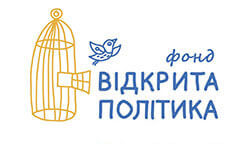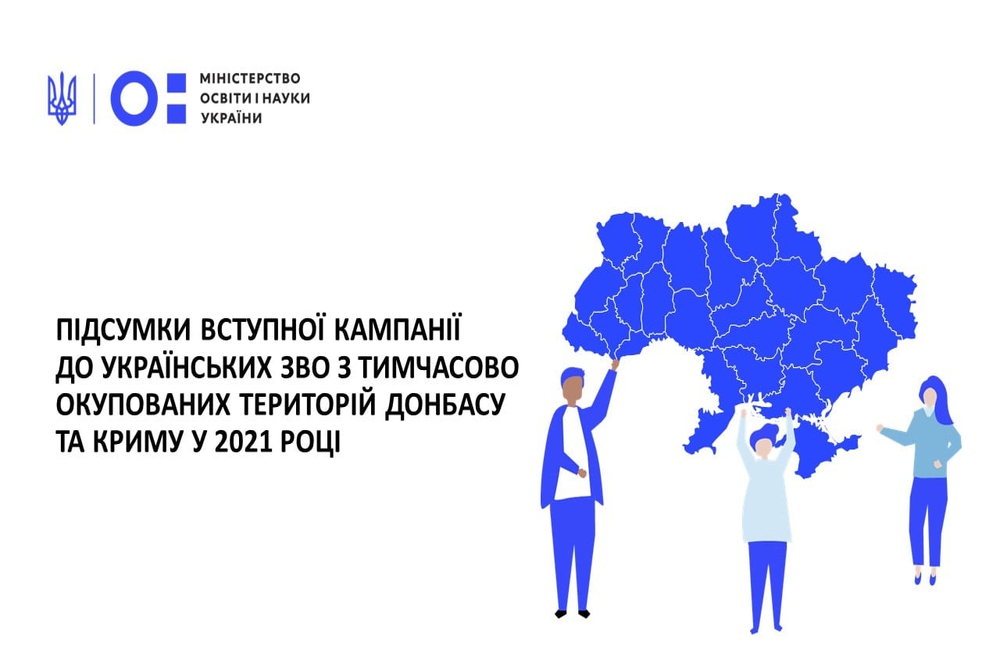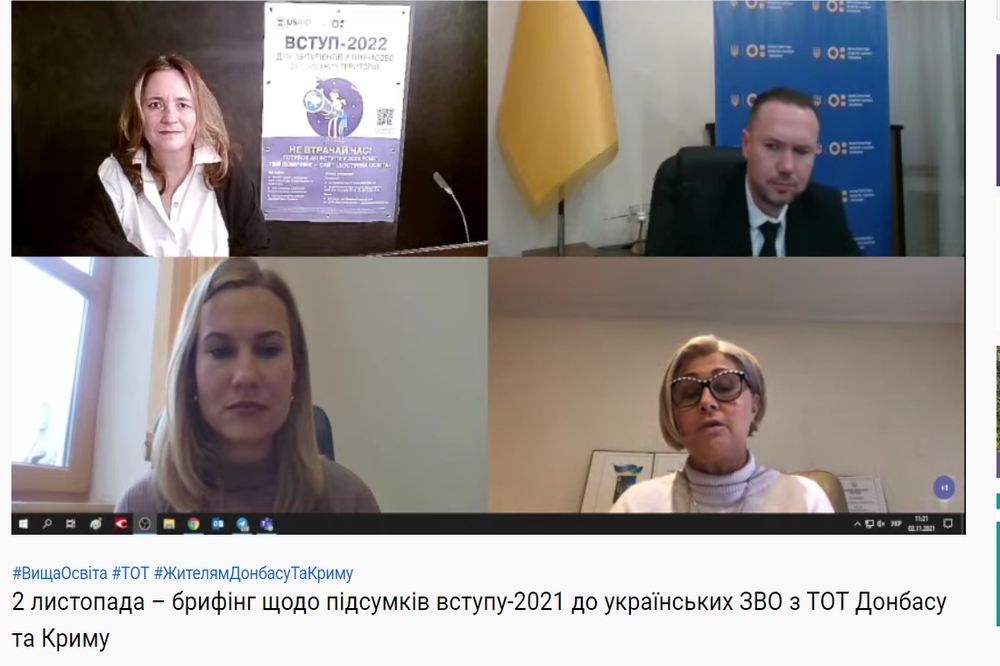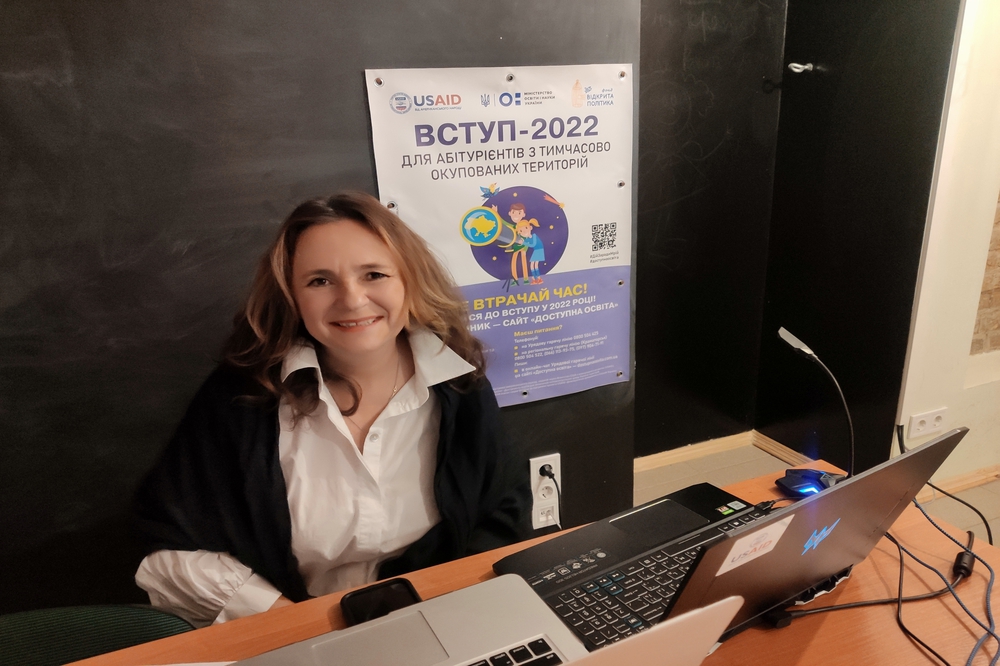News
Altogether 2083 residents of the temporarily occupied territories entered HEIs this year through the “Donbas/Crimea-Ukraine” education centers
Nov. 3, 2021, 11:10 a.m.On November 2, 2021, the Ministry of Education and Science of Ukraine and the NGO “Open Policy Foundation” held a press conference called “Results of the 2021 admission campaign to Ukrainian HEIs from the temporarily occupied territories of Donbas and Crimea”.
The press conference is organized by the Open Policy Foundation together with the Ministry of Education and Science of Ukraine with the support of the USAID “Democratic Governance in Eastern Ukraine” project.
According to the Minister of Education and Science of Ukraine Serhii SHKARLET, since the beginning of the “Donbas/Crimea-Ukraine” education centers’ activities, the number of entrants from the temporarily occupied territories to Ukrainian higher education institutions has doubled.
“If in 2016 1008 students entered Ukrainian HEIs, then in 2021 they were 2083,” the Minister noted.
According to the results of the admission campaign in 2021, the following higher education institutions became the most attractive for entrants through the “Donbas/Crimea-Ukraine” education centers: Volodymyr Dahl East Ukrainian National University (152 people), National Technical University “Kharkiv Polytechnic Institute” (124 people), V.N. Karazin Kharkiv National University (91 people), Luhansk Taras Shevchenko National University (89 people), and Horlivka Institute for Foreign Languages of the State Higher Educational Institution “Donbas State Pedagogical University” (85 people).
The top five HEIs, which enrolled entrants through the “Donbas/Crimea-Ukraine” education centers, includes V.I. Vernadsky Taurida National University (49 people), Kherson State Agrarian and Economic University (37 people), Taras Shevchenko National University of Kyiv (34 people), National Technical University of Ukraine “Ihor Sikorskyi Kyiv Polytechnic Institute” (21 people), and Bogomolets National Medical University (12 people).
Serhii SHKARLET also underlined that this year there was a decrease in the number of calls to the Government Hotline on Education for residents of the temporarily occupied territories.
“I am sure that this was conditioned by a broad information campaign for entrants from TOT. People were more likely to receive the necessary general information from other sources and therefore less likely to turn to a specialized hotline. And for these results, I am very grateful to all our partners,” Serhii SHKARLET emphasized.
According to the director of the “Government Contact Center” state institution Olha KHOLOMIEIEVA, this year the government hotline for entrants from TOT received more than 5 000 calls. The largest number of calls (56%) was received anonymously, i.e. without naming regions from which calls were made. Donetsk Oblast was in the 2nd place, Luhansk - in the 3rd, and Kyiv - in the 4th.
“I also want to emphasize once again that this year we have posted widgets to provide consultations with our specialists in chats not only on the website of the Ministry of Education and Science but also on the “Dostupna Osvita” (Affordable Education) website. This year, during the admission campaign, a large number of requests were received through the MoES’s chats - more than 20,000. About 80 appeals were received monthly through the chats of the “Dostupna Osvita” website. At the same time, the largest number of requests was received in July - amid the admission campaign. That is, obtaining information in chats is a priority for young people. Phone calls are more preferred by parents and older relatives. Young people communicate more in chats. This story needs to continue. We leave these chats on the “Dostupna Osvita” website to provide counseling, which will take place around the clock and all year round,” said Olha KHOLOMIEIEVA.
Iryna ZHDANOVA, Executive Director of the Open Policy Foundation, presented a survey entitled “2021 Admission Campaign: Achievements and Obstacles”, which was conducted in September and October this year with the support of the USAID “Democratic Governance in Eastern Ukraine” project. Altogether 262 respondents took part in the survey. Among them, there were students from TOT who entered higher education institutions, teachers and lecturers working with students from the temporarily occupied territories, representatives of the “Donbas/Crimea-Ukraine” education centers, heads of preparatory courses, and executive secretaries of admission committees.
According to Iryna ZHDANOVA, when asked “Why did you choose to receive education in Ukraine?”, 68% of students interviewed said that the motivation was related to greater prospects for a decent life, high chances for employment, and the opportunity to continue studying abroad.
Among the main problems during the entrance, students called insufficient knowledge of the Ukrainian language, the deadline for admission to the university came simultaneously with obtaining the results of an additional session of the external independent evaluation, “tricky” interrogations when crossing EECPs from the non-government controlled areas, fines at the border even if an invitation of the education center were available.
At the beginning of the study, psychological adaptation and insufficient knowledge of the Ukrainian language were called the main difficulties. At the same time, more than 70% said that they most needed help in their studies. Moreover, two-thirds of students rated the work of the education centers as the highest score, and 9 out of 10 respondents said that the system of admission through the education centers did not need to be changed.
“These are markers that educational institutions should pay attention to during the next admission campaign,” said Iryna ZHDANOVA. “In general, of course, the number of this year's entrants through the education centers is extremely inspiring, because it, in particular, shows the effectiveness of the information campaign. Over the years of the education centers’ work, more than 10,000 entrants from TOT and contact line areas have become students of Ukrainian universities due to the simplified admission procedure.”
The Executive Director of the Open Policy Foundation said that during the survey, 89% of students interviewed said that there was enough information about the admission campaign. There was a lack of data on the application procedure, the number of places for state-funded education, the possibility of receiving scholarships, and further employment. The main communication channels for most of the interviewed students were “word of mouth” (over 40%) - advice from friends, acquaintances, relatives; the MoES’s website and social networks, the “Dostupna Osvita” website, social networks of the Open Policy Foundation, advice from teachers of schools with distance learning, sites of education centers, and banners available at EECPs.
“At the same time, Ukrzaliznytsia, railway stations, transport, and television provided the least coverage as communication channels,” Iryna ZHDANOVA emphasized. “These data from sociological research should also be taken into account when planning a future campaign. In total, this year the information campaign for entrants from TOT, which was carried out by the Foundation together with the MoES with the support of USAID, covered more than 1 million people. For the information support of the 2021 admission campaign, the Foundation together with the MoES and GCC created more than 40 advertising products. These were banners, posters, infographics, booklets, animation, audio and video clips. Groups of ambassadors were also involved. These were students who had entered through the education centers in previous years. They distributed our products on their pages and told their peers about their positive experiences. More than 15 success stories based on real examples were created. All this was posted on the ‘Dostupna Osvita’ site.”
In addition, the survey shows that most children prepared for admission on their own. Therefore, it is important to give them the tools for quality self-paced training. Based on this, the Foundation posted on the “Dostupna Osvita” website online courses on preparation for External Independent Evaluation (EIE), State Final Attestation (SFA) in the Ukrainian Language and Literature, the History of Ukraine, and Mathematics. They are free and without registration.
“This year, we have created another tool for affordable education - web simulators to ensure the preparation for the SFA/EIE and online tests in the Ukrainian Language and Mathematics. They already help not only to improve their knowledge but also to psychologically prepare for testing,” Iryna ZHDANOVA said.
It is also important that in addition to the Government Hotline, there was also a regional hotline in Kramatorsk. The Foundation's consultants responded to messengers. The achievement of this year was that the Foundation together with the GCC launched a widget on the “Dostupna Osvita” website - an online chat of the Government Hotline.
As Iryna ZHDANOVA noted, the Open Policy Foundation has already launched the 2022 information campaign for entrants from TOT.
“After all, right now entrants make their choice and begin active preparation for admission,” said Executive Director of the Foundation. “Together with the MoES, the Foundation has developed information products for the upcoming admission campaign: posters titled “Admission-2022 through the Simplified Procedure”, “Distance Education in 2021/2022 for Children from TOT”, animated and audio clip called “Distance Education in 2021/2022 for Children from TOT”, which will be broadcast on Ukrainian Radio. Finally, I want to voice the most valuable result of the survey of students. While entering HEIs, one-third of the interviewed students already decided that they saw their future only in Ukraine! No wonder, we chose a telescope looking at Ukraine as a symbol of next year's information campaign.
The story of the entrant's mother. Names are changed for security reasons.
Oksana, a resident of Donetsk:
“We got to know about the simplified procedure for entering Ukrainian universities thanks to the ‘word of mouth’, and then we found information on the Internet. My son Ihor studied remotely at a school in a Government-controlled area and he received a certificate of general secondary education. He passed the EIE exams. But there were no results of the EIE for a long time. As a precaution, waiting for the results of the EIE, we went to take exams through an education center. Being already there, we received the results of the EIE.
It was very nice to receive support and consultations at the education center at all stages. As a result, the son entered an HEI on a state-funded basis. Now he is more or less adapted and has good relations with his classmates and neighbors in a dormitory.
I am very pleased. Earlier, I did not believe in the possibility of simplified admission, and now I assure acquaintances, who ask me,: ‘If you think that your child should study in Ukraine then be sure to try to enter through the education center. It really works.’”
Contact person: Alina Logvinenko, (063) 114-28-21,
e-mail: a.logvinenko@openpolicy.org.ua




